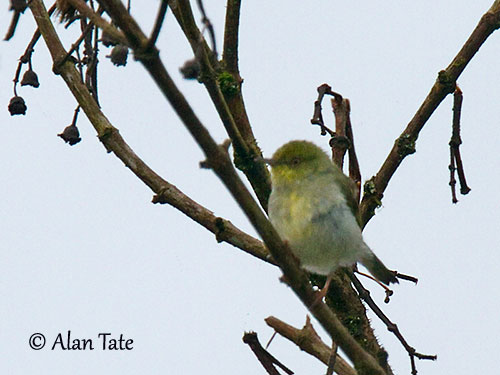
RANGE:
The Cryptic Warbler is found in E Madagascar, from Manongarivo and Tsaratanana massifs in NW and N, to Andohahela in far SE.
HABITAT:
The Cryptic Warbler occurs in mid-elevation and montane evergreen humid forests. It can be seen along steep ridges or in bamboo areas. It also frequents disturbed and degraded forest between 900 and 2,500 metres of elevation, and ventures into the vegetation above the treeline. In ridgetops, it favours areas with epiphytic moss and lichens.
CALLS AND SONGS: SOUNDS BY XENO-CANTO
The Cryptic Warbler’s call is a scolding “tsick” or “chick” or “chick-ess”. In alarm, this call is usually repeated in short series.
The song delivered from perch, starts with a harsh note followed by several notes on same pitch “chick tss-tss-tss-tss-tss-tss…” progressively fading away.
BEHAVIOUR IN THE WILD:
The Cryptic Warbler feeds on invertebrates, mainly insects, caterpillars and spiders.
It forages actively in trees and shrubs between 3 and 15 metres above the ground. It can be seen hopping along branches in trees. It gleans insects from outer foliage, bark or twigs. It may hang briefly while fluttering the wings. The largest items are beaten against hard surface to break them before to be eaten in separated pieces.
It often joins mixed-species foraging flocks.
The Cryptic Warbler sings while moving and foraging along a ridge, spending a few minutes at one perch before moving to another one. It can be seen singing with the bill pointing downwards, often diagonally, while the tail is pointing upwards.
The breeding behaviour is unknown.
The Cryptic Warbler is apparently sedentary on the island.
The flight is agile, but the short wings and the fairly long graduated tail only allow short-distance flights.
REPRODUCTION OF THIS SPECIES:
The breeding season takes place on October/December. The nest of the Cryptic Warbler is a globular structure concealed in the understorey. One nest was found in December at 1,625 metres of elevation on Andringitra, with three eggs. Adults were seen carrying food in early November, and juveniles were recorded three days later. Nest-site, eggs and young are not currently described. No more information.
PROTECTION / THREATS / STATUS:
The Cryptic Warbler was discovered in 1992 in the centre of the eastern rainforest of Madagascar. The species is relatively widespread and even locally common throughout its range. It is present in several national parks and reserves.
It depends on forest, but as the bird occurs in the high parts of the rainforest, it is less vulnerable to habitat destruction for agriculture expansion. However, the population is suspected to be declining.
The Cryptic Warbler is currently evaluated as Least Concern.
Fr: Cryptofauvette de Madagascar
Ang: Cryptic Warbler
All: Madagaskarsänger
Esp: Silvícola Críptico
Ita: Silvicola criptica
Nd: Cryptische Zanger
Sd: kryptisk madagaskarsångare
Photographers:
Alan & Ann Tate
AA Bird Photography
Text by Nicole Bouglouan
Sources :
HANDBOOK OF THE BIRDS OF THE WORLD Vol 11 by Josep del Hoyo, Andrew Elliott and David Christie - Lynx Edicions - ISBN: 849655306X
The Birds of Africa: Volume VIII: The Malagasy Region: Madagascar, Seychelles, Comoros, Mascarenes - Par Roger Safford, Frank Hawkins – ISBN: 1408190494, 9781408190494- Editeur: A&C Black, 2013
Wildlife of Madagascar par Ken Behrens, Keith Barnes - ISBN: 140088067X, 9781400880676 – Editeur: Princeton University Press, 2016
CREAGUS - MALAGASY WARBLERS Bernieridae
Fatbirder - Bernieridae - Malagasy Warblers
Wikipedia, the free encyclopaedia
Family Bernieridae
Page Order Passeriformes
Cryptic Warbler
Cryptosylvicola randrianasoloi
Passeriformes Order – Bernieridae Family
INTRODUCTION:
The Cryptic Warbler is endemic to Madagascar and was discovered in 1992. It occurs in the main humid evergreen forest of the E where it is patchily distributed up to the treeline. This gregarious, small warbler is often seen in mixed-species foraging flocks. It feeds on insects caught in canopy and subcanopy of trees and shrubs and is always very active.
The Cryptic Warbler is mainly found in the altitudinal band where it is less threatened by habitat destruction.
DESCRIPTION OF THE BIRD:
Biometrics:
Length: 12 cm
Weight: 7,8 – 9 g
The Cryptic Warbler has olive green upperparts but the uppertail-coverts and the tail are yellower. The tail is fairly long and graduated at tip. On the upperwings, the flight-feathers are dark greyish with yellowish olive green edges. Coverts and tertials are olive green.
The underparts are greyish-white with yellow wash on throat and upper breast. The undertail-coverts are olive green but the undertail is duller.
On the head, the crown is olive green. There is a narrow greenish-yellow supercilium and a dark olive green eye stripe. Cheeks and ear-coverts show greenish-yellow mottling.
The bill has black upper mandible with orange cutting edge. The lower mandible is dull orange with small blackish tip. The eyes are brown. The rather long, slender legs and the feet are blackish to dark brown.
Male and female are similar.
The juvenile is duller and greyer than adults. The supercilium is absent and the bill is all black.
